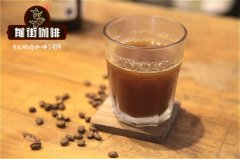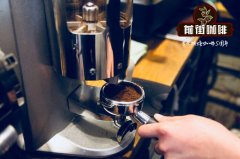The cooperative farm United by Kenyan coffee farmers is different from the autonomy of other large farms.
Professional coffee knowledge exchange More coffee bean information Please pay attention to coffee workshop (Weixin Official Accounts cafe_style)

Kenya borders Ethiopia to the north, where the Arabica coffee tree originated, but coffee cultivation did not begin until the early twentieth century. Missionaries introduced Arabica trees from Yemen in the 19th century, but did not plant them in large quantities until 1893, when they introduced the ancient seeds of Bourbon coffee from Brazil. Coffee in Kenya has Brazilian ancestry. Due to differences in water, climate and processing methods, Kenya beans have a completely different flavor from Brazilian beans. Brazilian coffee is grown at low altitudes, with soft texture and no obvious fruit acid flavor. Kenyan coffee trees, on the other hand, are concentrated on the slopes near Mount Kenya, between 4,000 feet and 6,500 feet above sea level, which is suitable for coffee bean flavor development, because the mountain temperature is lower, the growth is slower, the aromatic components of coffee beans are fully developed, the fruit acid flavor is more obvious, and the texture is harder. In addition, Kenya was a British colony in the early days, and the British have established a complete system of cultivation and quality control. After Kenya became independent, the coffee industry grew on an established basis.
There are two types of coffee farms in Kenya. One is a large plantation covering more than five acres, but the average elevation is lower. For Kenya coffee, the coffee beans of the large farm are only moderate in quality. The best Kenyan beans are produced in small farms, mostly located in the foothills or hillsides above 5,000 or 6,000 feet. Each small farmer can only produce about 20 to 70 bags per season. They cannot afford to invest in expensive washing and treatment plants. However, small farmers are very united. Hundreds or thousands of families set up cooperative farms. The washing and treatment plants are funded by the government. The coffee fruits picked by small farmers are sent to cooperative farms for unified processing. First, the half-ripe or rotten fruits are removed, and then peeled, fermented, The process of breaking down the pulp, removing the beans, drying and polishing is supervised by the official Coffee Authority, which is quite rigorous and ensures the quality of Kenyan coffee. Kenya bean washing processing technology and high standards of quality pipe, has been a model of bean producing countries.
Coffee is a part of African life, whether in the most remote parts of the Great Rift Valley, or in the Maasai nomadic Masai Mara steppe, whether urban or rural, can always smell the aroma of coffee, and look for incense to go, stay, taste, with a cup of coffee to carve those endless African time.
Kenya is located just a few hundred kilometers south of Ethiopia and Yemen, two of the world's most famous coffee producers, but Kenya has a far less established history of coffee cultivation than either country, with coffee seeds brought to the land by missionaries until the late 19th century.
Kenya's coffee trees bloom twice a year. Most coffee trees bloom in March and April after a long rainy season, and in most coffee producing areas the harvest season lasts from October to the end of the year. There are also coffee trees that bloom in October or November and are harvested the following July. Kenyan coffee has always been hand-picked, and farmers harvest only red, ripe beans, each tree roughly
Kenya is an African bean, with the unique sour taste of African beans (fruit acid, flower fragrance, citric acid fragrance... specific quality), generally if you want to mix it with other flavors, if you take it with very sour fruit, it may play the opposite result.
Start with neutral fruits, such as slightly sweet and light fruits, which highlight Kenya's acids (which are refreshing acids, not moldy acids).
If you are already deep baked (deep baking has actually turned into charcoal, the landlord should not use deep baking but medium deep), it is easy to set up, because the sour taste of deep baking is very little, full of heavy taste of coke flavor and strong fragrance, this time you have to fight heavy taste of fruit.
Important Notice :
前街咖啡 FrontStreet Coffee has moved to new addredd:
FrontStreet Coffee Address: 315,Donghua East Road,GuangZhou
Tel:020 38364473
- Prev

How many kinds of coffee grinders are there? How do I buy it? How can I make coffee without a coffee maker?
How many kinds of coffee grinders are there? How do I buy it? How can I make coffee without a coffee maker? Making coffee itself can be affected by many factors, such as coffee powder, proportion and water temperature. The quality of the bean grinder is important for a cup of coffee. An example is given to illustrate that the powder ground by a poor quality bean grinder is uneven in thickness, there are large grains and small grains, and a stream of hot water is washed down.
- Next

What should you know about the EK43 bean grinder? How can I make coffee powder without tools?
What should you know about the EK43 bean grinder? How can I make coffee powder without tools? Sometimes it is hard to say that there will be a turning point in the future, and it is useless to make predictions or forecasts useless. Just ask Thomas Watson, the former president of IBM, who confidently said in 1958 that "the perfect operation of the global market can be done with only five computers." Use a less funny one.
Related
- Detailed explanation of Jadeite planting Land in Panamanian Jadeite Manor introduction to the grading system of Jadeite competitive bidding, Red bid, Green bid and Rose Summer
- Story of Coffee planting in Brenka region of Costa Rica Stonehenge Manor anaerobic heavy honey treatment of flavor mouth
- What's on the barrel of Blue Mountain Coffee beans?
- Can American coffee also pull flowers? How to use hot American style to pull out a good-looking pattern?
- Can you make a cold extract with coffee beans? What is the right proportion for cold-extracted coffee formula?
- Indonesian PWN Gold Mandrine Coffee Origin Features Flavor How to Chong? Mandolin coffee is American.
- A brief introduction to the flavor characteristics of Brazilian yellow bourbon coffee beans
- What is the effect of different water quality on the flavor of cold-extracted coffee? What kind of water is best for brewing coffee?
- Why do you think of Rose Summer whenever you mention Panamanian coffee?
- Introduction to the characteristics of authentic blue mountain coffee bean producing areas? What is the CIB Coffee Authority in Jamaica?

